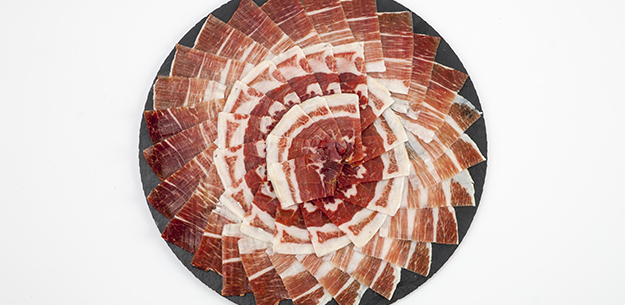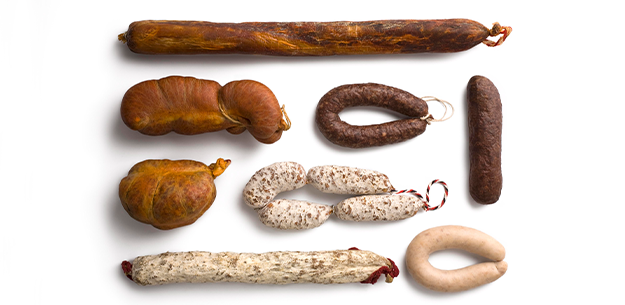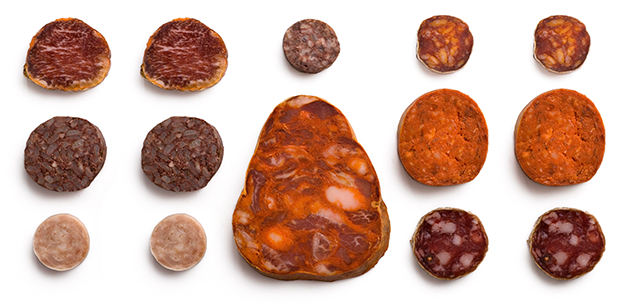.png.transform/rendition-xs/image_image%20(1).png)
Cured Ham & Charcuterie
Spain’s longstanding tradition of curing hams and other meat products is the result of a combination of geographic, climatic, historic, cultural and even religious factors, because the massive adoption of the pig was one of the many legacies of Roman civilization throughout Christendom.
Serrano ham and other cured hams
If any one product could be singled out to represent the essence of Spanish gastronomy, it might well be cured ham, the noblest of pork products. Anyone coming to Spain for the first time will immediately be impressed by the omnipresence of ham, not only in practically all food stores and catering establishments, but also in the subconscious of Spaniards, where it takes on an almost mythical nature.
Spain’s longstanding tradition of curing hams and other meat products is the result of a combination of geographic, climatic, historic, cultural and even religious factors, because the massive adoption of the pig was one of the many legacies of Roman civilization throughout Christendom. At that time, hams were already being covered with salt for a number of days then cured in mountain air, whence the term serrano, meaning ‘from the mountains’. Today this term is reserved for cured ham made from white pigs (those from Ibérico pigs are called Ibérico hams), especially the Duroc, Landrace and Large White breeds, that meet the requirements of the Traditional Speciality Guaranteed (TSG) Jamón Serrano label.
Today, Spain has the largest figures worldwide for ham production and consumption. Although many hams are still cured in the traditional, artisan way, the old, natural drying-chambers have largely been replaced by modern chillers that maintain the ideal temperature and humidity conditions throughout the process.
There are different levels of quality for cured ham depending on the origin of the fresh meat, the breed and diet of the pig, how it is tended and slaughtered, the skill and care of the producers and the duration of the whole process. The minimum curing period is seven months, but it may be much longer depending on the initial weight of the ham and other factors.
Some districts and towns have become renowned for the tradition and quality of their white pork cured hams and bear the corresponding quality seal. These include the hams of Protected Denomination of Origin (PDO) Jamón de Teruel in Aragón and Protected Geographical Indication (PGI) Jamón de Trévelez in the Alpujarra mountains in Granada, Andalusia.
In view of their local characteristics, these hams are known by their place of origin, as opposed to using the general term “serrano” which is used exclusively for production following the TSG Jamón Serrano label regulations.
When cut, a good Serrano ham should have a shiny appearance, varying in color from pink to purplish red. The texture should be firm and not very fibrous, and the flavor intense, delicate, not very salty, smooth on the palate and with a very characteristic aroma.
Ham is rich in proteins, vitamins and minerals. Its fat content is moderate, with a predominance of unsaturated fats. The salt added during curing guarantees its microbiological safety, although new technologies have made it possible to greatly reduce the use of salt, achieving a healthier, more balanced product.
Spaniards are passionate about ham. It is consumed at any time of day or night and at every type of celebration. Sliced wafer-thin and served with good bread, it is the epitome of famous tapas. But it can be served in a multitude of ways – with fresh tomatoes, melon or other fruit, as a garnish for cold sups such as gazpacho and salmorejo or as an ingredient in salads and cooked dishes to which it always contributes its unmistakable personality.
Pork charcuterie
Geography, history and tradition combine in Spain to produce an extensive catalogue of cured sausages which, alongside cured hams and Ibérico pork products, are some of the most characteristic foods in the Spanish larder.
In order to make our way through the enormous variety of Spanish sausage products, we should start by looking at how they are made. For starters, they are generally made from pork from the Duroc, Landrace and Large White pig breeds There are two main categories of products: raw products which are then dried or cured, and cooked products. The paradigm of the former is chorizo, which is matured not only by time and air, but also by the salt and spices that are added to the pork, with emphasis on pimentón, the main distinguishing ingredient.
The most representative of the cooked products is morcilla (blood sausage), of which there are many versions. Other products are first cooked and then cured, such as the many butifarra sausages made in Mediterranean regions (and particularly in Catalonia), and the smoked sausages that are typical of Galicia and other mountainous, rainy parts of northern Spain.
In the Mediterranean regions of Catalonia, the Valencian Community and the Balearic Islands, most of the pork products are cooked, and the seasoning of choice is often black pepper rather than pimentón. One exception in this region which does use pimentón is the famous sobrassada from Majorca. In the rest of Spain, including the Canary Islands, curing is the usual method, mostly for chorizo and blood sausage, and pimentón is widely used as flavoring.
In any case, there is not a single region or district in Spain without its own ancestral recipes and sausage-making traditions. Most of the products retain their local name and some have become known far from their place of origin, such as morcilla de Burgos, or PGI Chorizo de Cantimpalos (Segovia), both traditional products from Castile-León.
Charcuterie is usually consumed as it comes but many types may also be roasted, grilled, fried or used as ingredients in a large range of regional dishes. The well-known fabada (a bean stew made with Asturian faba beans) would be unthinkable without the chorizo, blood sausage and pork fat from Asturias. The same can be said about the fresh chorizo in patatas a la riojana, or the many versions of stew known as cocidos which would not be the same without their local charcuterie products. The huge range of flavors, aromas, shapes, textures and colors of Spanish charcuterie is practically unique the world over, and represents a distinctive contribution to western pork gastronomy.
Geography, history and tradition combine in Spain to produce an extensive catalogue of cured sausages which, alongside cured hams and Ibérico pork products, are some of the most characteristic foods in the Spanish larder.
Santiago Botas/@ICEX. Edited by Adrienne Smith/@ICEX



- /content/dam/en/icex-foodswines/images/products/serrano-cured-hams-charcuterie/Serrano,%20Cured%20Hams%20%20Charcuterie%20carr1.png
- /content/dam/en/icex-foodswines/images/products/serrano-cured-hams-charcuterie/Serrano,%20Cured%20Hams%20%20Charcuterie%20carr2.png
- /content/dam/en/icex-foodswines/images/products/serrano-cured-hams-charcuterie/Serrano,%20Cured%20Hams%20%20Charcuterie%20carr3.png
